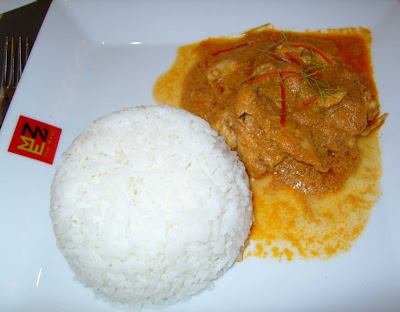
Lemongrass
A popular flavoring, only the tender middle of lemongrass stalks should be used. It is a main ingredient for favorite Tom yum soup.
Thai sweet Basil
Thai sweet basil is the most common. This has purplish stems, green leaves and an aniseed aroma and flavour. It is aromatic and is used in curries, soups and stir-fries, as well as sometimes being served as an accompaniment to “Nam Prik”.
Holy Basil
Is either red or green with slightly pointed, variegated leaves, Holy basil is used in stir-fries and fish dishes.
Galangal
A rhizome with a hot peppery flavor. Young pale galangal can be eaten in pieces; older redder pieces are best used in curry pastes.
Turmeric
A rhizome like ginger and galangal. In Thailand turmeric comes in white and yellow varieties. The yellow type is often referred to as red and is used fresh in curry pastes. Dried, it adds a yellow colour to curries, particularly Northern “khao sawy”. The white type is often eaten raw as a vegetable accompaniment to “nam prik”.
Cilantro
We can use every part of the plant: the stems are used for flavoring; the leaves in stir-fries, soups and noodle dishes; and as a garnish, the seeds for spice paste and the roots are used, too.
Mint
Mint has been used in many Thai dishes especially salad (Yum) such as Beef salad (Yum nua), Chicken salad (Larb gai) because it has a fresh and aroma.
Garlic
Crushed garlic, cilantro root and pepper is the foundation of many dishes in Thailand even the dipping sauce. It is an essential ingredient in the famous Thai curry pastes, also.
Ginger
A rhizome of a tropical plant which is sold in “hands". Fresh young ginger should have a smooth, pinkish beige skin and be firm and juicy. As it ages, the skin toughens and the flesh becomes more fibrous. Avoid old ginger which is wrinkled as it will be tough.
Kaffir Lime Leaves
This kaffir lime leaves are synonymous with Thai cooking, the leaves are torn or finely shredded and used in soups, especially Tom yum soups and Panang curry.
Curry Powder
Usually bough ready made in Thailand as it is not widely used except in a few stir-fries, marinades, sauces ,curry puffs, and yellow curry.
Coriander Seeds
The round seeds of the coriander plant have a spicy aroma and are used in some curry pastes, especially those that are Indian style.
Cardamom
A round white variety of cardamom is used in Indian or Muslim-influenced curries such as massaman.
Cumin Seeds
These have a peppery, slightly bitter flavor and are used in some curry pastes, available whole or ground.
Chinese Keys
A rhizome with skinny fingers that hang down like a bunch of keys. Has a peppery flavor which normally used in a red curry or stir-fried catfish with red curry paste (pad ped pla duk).

















